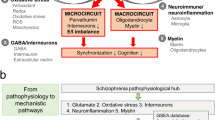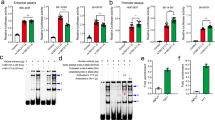Abstract
Genome-wide association studies have reported an association between schizophrenia and rs12807809 of the neurogranin (NRGN) gene. We have recently found that an rs12807809–rs12278912 haplotype of the gene is associated with schizophrenia in a Japanese population and that the NRGN expression of the high-risk TG haplotype is lower than that of the protective TA haplotype in immortalized lymphoblasts. In this study, we investigated the influences of neurogranin genotypes (rs12807809 and rs12278912), haplotypes and diplotypes and genetic variant–diagnosis interactions on intellectual ability in 414 Japanese patients with schizophrenia and healthy subjects. We detected possible effects of the genome-wide screen-supported rs12807809, haplotypes, diplotypes and their genetic variant–diagnosis interactions on intellectual abilities at the threshold level of P<0.05. After applying Bonferroni correction for 13 genotype measures and setting P-values for significance (P<0.0039; 0.05/13), three effects remained significant: the rs12807809–rs12278912 diplotype–diagnosis interactions on performance intelligence quotient (CG/CG: P=3.9 × 10−13; TA/TA: P=1.1 × 10−7) and TA/TA diplotype on performance intelligence quotient in patients with schizophrenia (P=8.2 × 10−8) remained significant. The intellectual abilities of the high-risk TG/TG diplotype of the neurogranin gene were lower compared to those with the non-risk TA/TA diplotype. Our findings suggest that the genetic risk variant in the neurogranin gene may be related to reduced intellectual ability.
Similar content being viewed by others


Log in or create a free account to read this content
Gain free access to this article, as well as selected content from this journal and more on nature.com
or
References
Cardno, A. G. & Gottesman, I. I. Twin studies of schizophrenia: from bow-and-arrow concordances to star wars Mx and functional genomics. Am. J. Med. Genet 97, 12–17 (2000).
Tsuang, M Schizophrenia: genes and environment. Biol. Psychiatry 47, 210–220 (2000).
Sun, J., Kuo, P. H., Riley, B. P., Kendler, K. S. & Zhao, Z. Candidate genes for schizophrenia: a survey of association studies and gene ranking. Am. J. Med. Genet. B 147B, 1173–1181 (2008).
Stefansson, H., Ophoff, R. A., Steinberg, S., Andreassen, O. A., Cichon, S., Rujescu, D. et al. Common variants conferring risk of schizophrenia. Nature 460, 744–747 (2009).
Ohi, K., Hashimoto, R., Yasuda, Y., Fukumoto, M., Yamamori, H., Umeda-Yano, S. et al. Functional genetic variation at the NRGN gene and schizophrenia: evidence from a gene-based case-control study and gene expression analysis. Am. J. Med. Genet. B 159B, 405–413 (2012).
Steinberg, S., de Jong, S., Andreassen, O. A., Werge, T., Borglum, A. D., Mors, O. et al. Common variants at VRK2 and TCF4 conferring risk of schizophrenia. Hum. Mol. Genet. 20, 4076–4081 (2011).
Martinez de Arrieta, C., Perez Jurado, L., Bernal, J. & Coloma, A. Structure, organization, and chromosomal mapping of the human neurogranin gene (NRGN). Genomics 41, 243–249 (1997).
Baudier, J., Deloulme, J. C., Van Dorsselaer, A., Black, D. & Matthes, H. W. Purification and characterization of a brain-specific protein kinase C substrate, neurogranin (p17). Identification of a consensus amino acid sequence between neurogranin and neuromodulin (GAP43) that corresponds to the protein kinase C phosphorylation site and the calmodulin-binding domain. J. Biol. Chem. 266, 229–237 (1991).
Hayashi, Y. Long-term potentiation: two pathways meet at neurogranin. EMBO J. 28, 2859–2860 (2009).
Li, J., Pak, J. H., Huang, F. L. & Huang, K. P. N-methyl-D-aspartate induces neurogranin/RC3 oxidation in rat brain slices. J. Biol. Chem. 274, 1294–1300 (1999).
Huang, F. L., Huang, K. P. & Boucheron, C. Long-term enrichment enhances the cognitive behavior of the aging neurogranin null mice without affecting their hippocampal LTP. Learn. Mem. 14, 512–519 (2007).
Zhabotinsky, A. M., Camp, R. N., Epstein, I. R. & Lisman, J. E. Role of the neurogranin concentrated in spines in the induction of long-term potentiation. J. Neurosci. 26, 7337–7347 (2006).
Pak, J. H., Huang, F. L., Li, J., Balschun, D., Reymann, K. G., Chiang, C. et al. Involvement of neurogranin in the modulation of calcium/calmodulin-dependent protein kinase II, synaptic plasticity, and spatial learning: a study with knockout mice. Proc. Natl Acad. Sci. USA 97, 11232–11237 (2000).
Miyakawa, T., Yared, E., Pak, J. H., Huang, F. L., Huang, K. P. & Crawley, J. N. Neurogranin null mutant mice display performance deficits on spatial learning tasks with anxiety related components. Hippocampus 11, 763–775 (2001).
Pohlack, S. T., Nees, F., Ruttorf, M., Witt, S. H., Nieratschker, V., Rietschel, M. et al. Risk variant for schizophrenia in the neurogranin gene impacts on hippocampus activation during contextual fear conditioning. Mol. Psychiatry 16, 1072–1073 (2011).
Broadbelt, K., Ramprasaud, A. & Jones, L. B. Evidence of altered neurogranin immunoreactivity in areas 9 and 32 of schizophrenic prefrontal cortex. Schizophr. Res. 87, 6–14 (2006).
Ohi, K., Hashimoto, R., Yasuda, Y., Nemoto, K., Ohnishi, T., Fukumoto, M. et al. Impact of the genome wide supported NRGN gene on anterior cingulate morphology in schizophrenia. PLoS One 7, e29780 (2012).
Krug, A., Krach, S., Jansen, A., Nieratschker, V., Witt, S. H., Shah, N. J. et al. The effect of neurogranin on neural correlates of episodic memory encoding and retrieval. Schizophr. Bull. 39, 141–150 (2013).
Ramsden, S., Richardson, F. M., Josse, G., Thomas, M. S., Ellis, C., Shakeshaft, C. et al. Verbal and non-verbal intelligence changes in the teenage brain. Nature 479, 113–116 (2011).
Weickert, T. W., Goldberg, T. E., Gold, J. M., Bigelow, L. B., Egan, M. F. & Weinberger, D. R. Cognitive impairments in patients with schizophrenia displaying preserved and compromised intellect. Arch. Gen. Psychiatry 57, 907–913 (2000).
Heaton, R. K., Gladsjo, J. A., Palmer, B. W., Kuck, J., Marcotte, T. D. & Jeste, D. V. Stability and course of neuropsychological deficits in schizophrenia. Arch. Gen. Psychiatry 58, 24–32 (2001).
Toulopoulou, T., Goldberg, T. E., Mesa, I. R., Picchioni, M., Rijsdijk, F., Stahl, D. et al. Impaired intellect and memory: a missing link between genetic risk and schizophrenia? Arch. Gen. Psychiatry 67, 905–913 (2011).
Posthuma, D., de Geus, E., J. & Boomsma, D. I. Perceptual speed and IQ are associated through common genetic factors. Behav. Genet. 31, 593–602 (2001).
Husted, J. A., Lim, S., Chow, E. W., Greenwood, C. & Bassett, A. S. Heritability of neurocognitive traits in familial schizophrenia. Am. J. Med. Genet. B 150B, 845–853 (2009).
Fowler, T., Zammit, S., Owen, M. J. & Rasmussen, F. A. population-based study of shared genetic variation between premorbid IQ and psychosis among male twin pairs and sibling pairs from Sweden. Arch. Gen. Psychiatry 69, 460–466 (2012).
van Scheltinga, A. F., Bakker, S. C., van Haren, N. E., Derks, E. M., Buizer-Voskamp, J. E., Cahn, W. et al. Schizophrenia genetic variants are not associated with intelligence. Psychol. Med. 1–8 (2013).
Toulopoulou, T., Picchioni, M., Rijsdijk, F., Hua-Hall, M., Ettinger, U., Sham, P. et al. Substantial genetic overlap between neurocognition and schizophrenia: genetic modeling in twin samples. Arch. Gen. Psychiatry 64, 1348–1355 (2007).
Donohoe, G., Walters, J., Morris, D. W., Da Costa, A., Rose, E., Hargreaves, A. et al. A neuropsychological investigation of the genome wide associated schizophrenia risk variant NRGN rs12807809. Schizophr. Res. 125, 304–306 (2011).
Krug, A., Krach, S., Jansen, A., Nieratschker, V., Witt, S. H., Shah, N. J. et al. The effect of neurogranin on neural correlates of episodic memory encoding and retrieval. Schizophr. Bull. 39, 141–150 (2013).
Hashimoto, R., Ohi, K., Yasuda, Y., Fukumoto, M., Iwase, M., Iike, N. et al. The impact of a genome-wide supported psychosis variant in the ZNF804A gene on memory function in schizophrenia. Am. J. Med. Genet. B 153B, 1459–1464 (2010).
Ohi, K., Hashimoto, R., Yasuda, Y., Yoshida, T., Takahashi, H., Iike, N. et al. Association study of the G72 gene with schizophrenia in a Japanese population: a multicenter study. Schizophr. Res. 109, 80–85 (2009).
Hashimoto, R., Hashimoto, H., Shintani, N., Chiba, S., Hattori, S., Okada, T. et al. Pituitary adenylate cyclase-activating polypeptide is associated with schizophrenia. Mol. Psychiatry 12, 1026–1032 (2007).
Hashimoto, R., Numakawa, T., Ohnishi, T., Kumamaru, E., Yagasaki, Y., Ishimoto, T. et al. Impact of the DISC1 Ser704Cys polymorphism on risk for major depression, brain morphology and ERK signaling. Hum. Mol. Genet. 15, 3024–3033 (2006).
Wechsler, D. Manual for the Wechsler Adult Intelligence Scale-III (The Psychological Corporation: San Antonio, TX, USA, 1997).
Lindenmayer, J. P., Bernstein-Hyman, R. & Grochowski, S. A new five factor model of schizophrenia. Psychiatr. Q. 65, 299–322 (1994).
Li, S. S., Khalid, N., Carlson, C. & Zhao, L. P. Estimating haplotype frequencies and standard errors for multiple single nucleotide polymorphisms. Biostatistics 4, 513–522 (2003).
Faul, F., Erdfelder, E., Lang, A. G. & Buchner, A. G*Power 3: a flexible statistical power analysis program for the social, behavioral, and biomedical sciences. Behav. Res. Methods 39, 175–191 (2007).
Acknowledgements
We thank all of the individuals who participated in this study. This work was supported by research grants from the Japanese Ministry of Health, Labor and Welfare (H22-seishin-ippan-001); Japanese Ministry of Education, Culture, Sports, Science and Technology (MEXT) KAKENHI (22390225-Grant-in-Aid for Scientific Research (B) and 23659565-Grant-in-Aid for Challenging Exploratory Research); CREST of JST; and the Japan Foundation for Neuroscience and Mental Health.
Author information
Authors and Affiliations
Corresponding author
Ethics declarations
Competing interests
The authors declare no conflict of interest.
Additional information
Supplementary Information accompanies the paper on Journal of Human Genetics website
Supplementary information
Rights and permissions
About this article
Cite this article
Ohi, K., Hashimoto, R., Yasuda, Y. et al. Influence of the NRGN gene on intellectual ability in schizophrenia. J Hum Genet 58, 700–705 (2013). https://doi.org/10.1038/jhg.2013.82
Received:
Revised:
Accepted:
Published:
Issue date:
DOI: https://doi.org/10.1038/jhg.2013.82
Keywords
This article is cited by
-
Association between NRGN gene polymorphism and resting-state hippocampal functional connectivity in schizophrenia
BMC Psychiatry (2019)
-
Non-coding RNA dysregulation in the amygdala region of schizophrenia patients contributes to the pathogenesis of the disease
Translational Psychiatry (2018)
-
Individual risk alleles of susceptibility to schizophrenia are associated with poor clinical and social outcomes
Journal of Human Genetics (2016)
-
De Novo ring chromosome 11 and non-reciprocal translocation of 11p15.3-pter to 21qter in a patient with congenital heart disease
Molecular Cytogenetics (2015)

